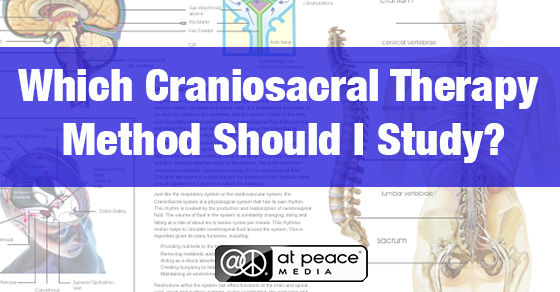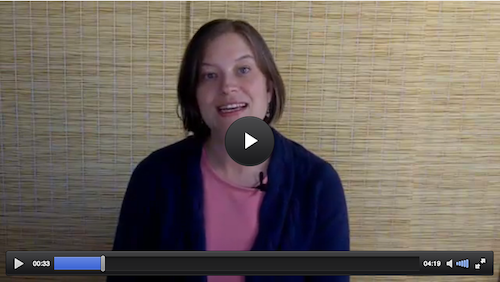Which craniosacral therapy method should I choose to study?
We're very happy to have Lisa Gillispie as our guest blogger today! She's a gifted therapist and educator, and she will be a Featured Presenter at our October 29 Tools for Touch CE Webinar this month! Click here to register early.
I began my journey into CranioSacral therapy as a bit of a skeptic. I took a beginner class in massage school and I think I was the only one in that class who didn't really feel anything. The other students were chatting back and forth, sharing with each other the different subtleties and sensations they were feeling. I was so frustrated. I felt totally left out and wondered "What are you talking about? I cannot feel a THING!"
After I got my massage license, I was looking into continuing education. Turned out that the Upledger Institute was coming to town with classes, and I thought "What the heck, I'll try it." So in spite of my negative previous experience with craniosacral therapy, I went ahead and took CST I. And I fell completely in love with it. Finally I was able to feel what the other students were feeling in my beginner class and I was as enthralled as they had been. I wanted to hone my skills and get a better sense of what I knew craniosacral therapy could offer people. I loved the in-depth anatomy studies (I'm a total anatomy geek) and I knew I would never get bored with learning and fine-tuning my skills. I also liked the body-mind connection in craniosacral therapy.

I completed advanced training through the Upledger Institute. I've also received training through other schools. So, I call myself a bit of a hybrid because not just one school informs my perspective. I've worked with a variety of clients: infants, new moms, developmentally delayed kids, teenagers, adults who've been in car accidents or suffer with life-threatening illnesses or chronic pain, and occasionally I've gotten to work with the elderly.
There are many things about craniosacral therapy that I love. I love the subtlety of the work, there are so many things the body will show us when we pay attention and listen. It's also fairly easy on my body and my hands. CST isn’t a technique that causes a lot of wear and tear on my body. There's always, always more to learn. The more I hone my skills, the more the body teaches me... in the moment, on the table. It has opened my eyes about life and the world.
Art available at craniosacral-art.com
If you're interested in craniosacral therapy, consider pursuing training and gathering all of the information you can about it. I think in general it's really important to choose an area to specialize in. I'm really passionate about that because I know it will help you to grow your business, whether you choose craniosacral therapy or not. Pick an area to specialize in, pick a population or demographic to specialize in, as well. As paradoxical as it sounds, focusing on a specialty will help you build your practice and get more clients.
So, now you want to get trained in craniosacral therapy and you’re wondering "where do I go?"
As with most things, there is no straight-forward, easy answer that applies to everyone. Each massage therapist must first figure out which school of craniosacral therapy you want to specialize in, then where and how to get training and certification. We'll start with an overview of the different craniosacral methods.

Click here to watch Lisa's video at Massage Learning Network
Overview of craniosacral therapies
There are three main schools of thought or methodologies for craniosacral therapy.
1. Upledger Institute International
2. Milne Institute
3. Biodynamic method
All of these methods offer a core-set of training in craniosacral therapy, and also certification so that once you've completed the required levels of training you can say "I am now certified in that particular method."
A note on style: Upledger is a more mechanical, technique oriented approach. Biodynamic is the least directive and techniques oriented of the 3 schools. There is a focus on the various rhythms of the body and the fluids - known as the tides. The practitioner focuses on holding an agenda free, supportive space that helps the body make it’s own corrections in its own time. The Milne model combines deep listening with supportive corrective techniques and includes shamanic healing methods.
All three school focus on listening to the body and respecting the innate healing wisdom of the body.
There are also some individual therapists who have put together their own craniosacral coursework. Taking the best of their own training and experience and adding in what they feel is most helpful for new therapists. If you are interested in a mother/baby focus, I highly recommend exploring Carol Gray’s work. If you’re seeking in-depth training with a smaller class group I recommend considering Dave Tomlinson’s program.
Research
Each school has their own philosophy of how to practice craniosacral therapy. They don't agree with each other on everything, not a big surprise. My advice is to check out each of the websites, get a feel for how they work, how they are organized, and how they present the information. There are many books and articles available for each of the styles.
Get a Treatment
Next, receive a treatment from someone who has been certified in that particular method. Ask the therapist questions about their training, where they went, what they liked and disliked.
Take Action
Then, gather information about what it takes to get certified and what the particular training program consists of. Do you have to travel? How much time will it take? What will it cost? Do you have to complete the training within a certain time frame or do you have more flexibility? You know yourself best, so find a training schedule that fits your needs.
Gather information. Receive treatment. Explore what each school has to offer and see which one feels like the best fit for you!
Regardless of what school of thought you choose, cranniosacral therapy is an amazing gift to offer to your clients and I wish you best of luck!
Lisa Gillispie is a CranioSacral therapist & mentor and Restorative Exercise Specialist™ at Anatomy Conversations. She also has a private practice in Columbus, Ohio, specializing in CranioSacral therapy and Restorative Exercise Specialist™ Gillispie Partners in Wellness.

